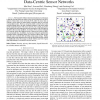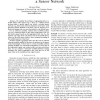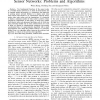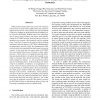INFOCOM
2007
IEEE
14 years 5 months ago
2007
IEEE
—The demand for efficient data dissemination/access techniques to find the relevant data from within a sensor network has led to the development of data-centric sensor networks...
INFOCOM
2007
IEEE
14 years 5 months ago
2007
IEEE
— Existing work on placing additional relay nodes in wireless sensor networks to improve network connectivity typically assumes homogeneous wireless sensor nodes with an identica...
INFOCOM
2007
IEEE
14 years 5 months ago
2007
IEEE
— We consider the problem of aggregating data at a mobile fusion center (fusor) (eg. a PDA or a cellular phone) moving within a spatial region over which a wireless sensor networ...
INFOCOM
2007
IEEE
14 years 5 months ago
2007
IEEE
— Two fundamental functions of the sensor nodes in a wireless sensor network are to sense its environment and to transmit sensed information to a basestation. One approach to pro...
INFOCOM
2007
IEEE
14 years 5 months ago
2007
IEEE
—Many sensor network protocols in the literature implicitly assume that sensor nodes are deployed uniformly inside a simple geometric region. When the real deployment deviates fr...
IEEEARES
2007
IEEE
14 years 5 months ago
2007
IEEE
— Node compromise is a serious threat in wireless sensor networks. An adversary can use compromised nodes to inject false data into the network forging events to deceive the base...
ICDCSW
2007
IEEE
14 years 5 months ago
2007
IEEE
Recent secure code-update protocols for sensor networks have been based on asymmetric-crypto primitives such as digital signatures. Our approach, Castor, explores the feasibility ...
ICDCS
2007
IEEE
14 years 5 months ago
2007
IEEE
While extensive studies have been carried out in the past several years for many sensor applications, they cannot be applied to the network with extremely low and intermittent con...
ICCCN
2007
IEEE
14 years 5 months ago
2007
IEEE
Abstract— With the rapid deployment of wireless sensor networks, there are several new sensing applications with specific requirements. Specifically, target tracking applicatio...
ICCCN
2007
IEEE
14 years 5 months ago
2007
IEEE
Abstract— This paper proposes a simple yet efficient localization algorithm for GPS-free sensor nodes in wireless sensor networks (WSN). Our approach is hybrid in the sense that...




